HA565 - EHR Implementation: ONC & HL7 Roles, Privacy & Regulations
VerifiedAdded on 2023/04/03
|6
|1134
|251
Report
AI Summary
This report provides an executive summary of the current activities of the National Coordinator for Health Information Technology (ONC) and Health Level Seven® International (HL7) regarding the implementation of Electronic Health Records (EHRs). It highlights key improvements and initiatives such as enhancing EHR usability, the Draft Standard for Trial Use (DSTU) model, adherence to HIPAA privacy rules, staff training, and ensuring data integrity and accessibility. The report emphasizes the benefits of EHRs, including improved data security, reduced paperwork, enhanced diagnostic accuracy, and efficient clinical workflows, recommending their widespread adoption in healthcare institutions. The document also discusses the importance of data governance principles in ensuring the quality of health data.
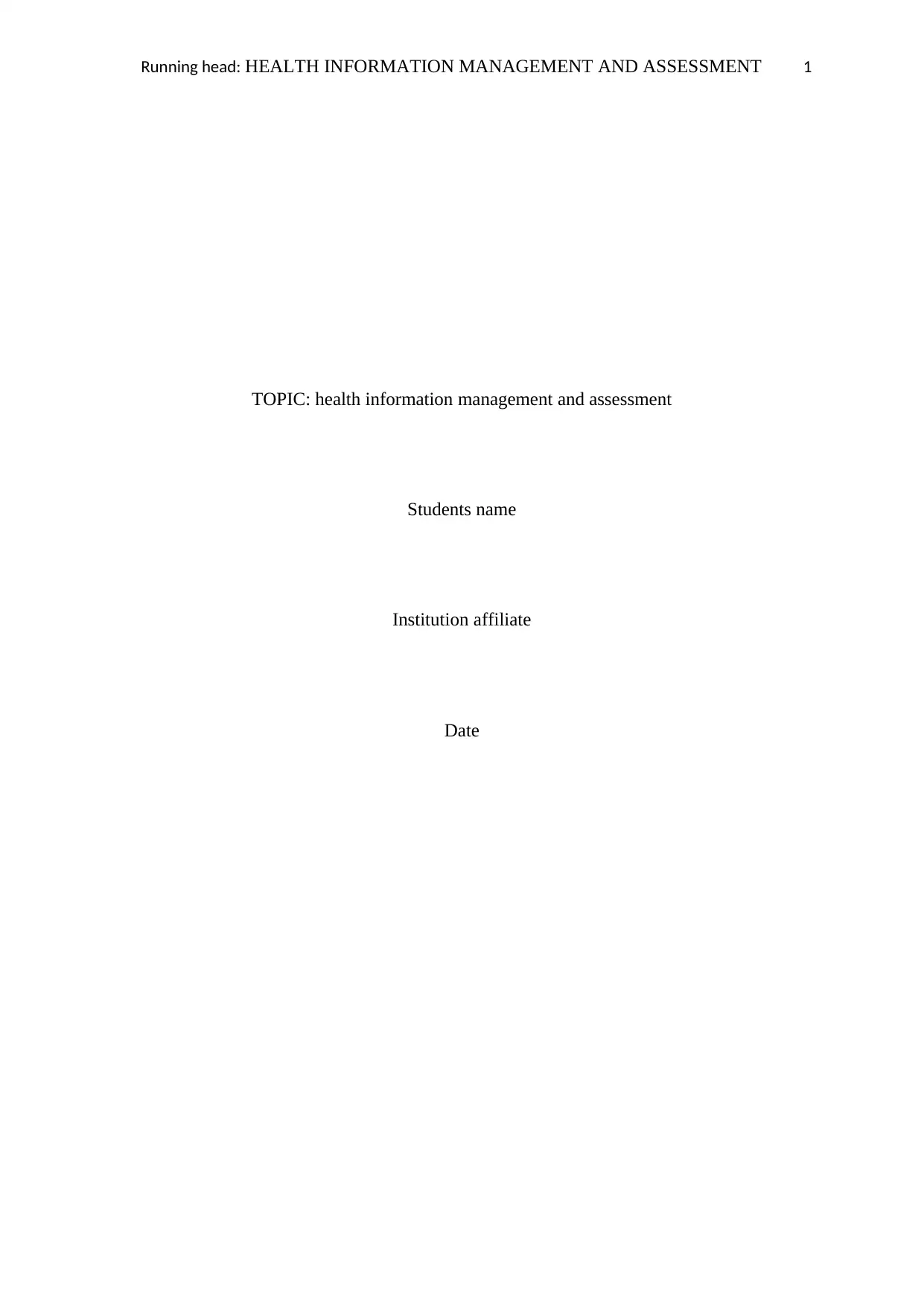
Running head: HEALTH INFORMATION MANAGEMENT AND ASSESSMENT 1
TOPIC: health information management and assessment
Students name
Institution affiliate
Date
TOPIC: health information management and assessment
Students name
Institution affiliate
Date
Paraphrase This Document
Need a fresh take? Get an instant paraphrase of this document with our AI Paraphraser
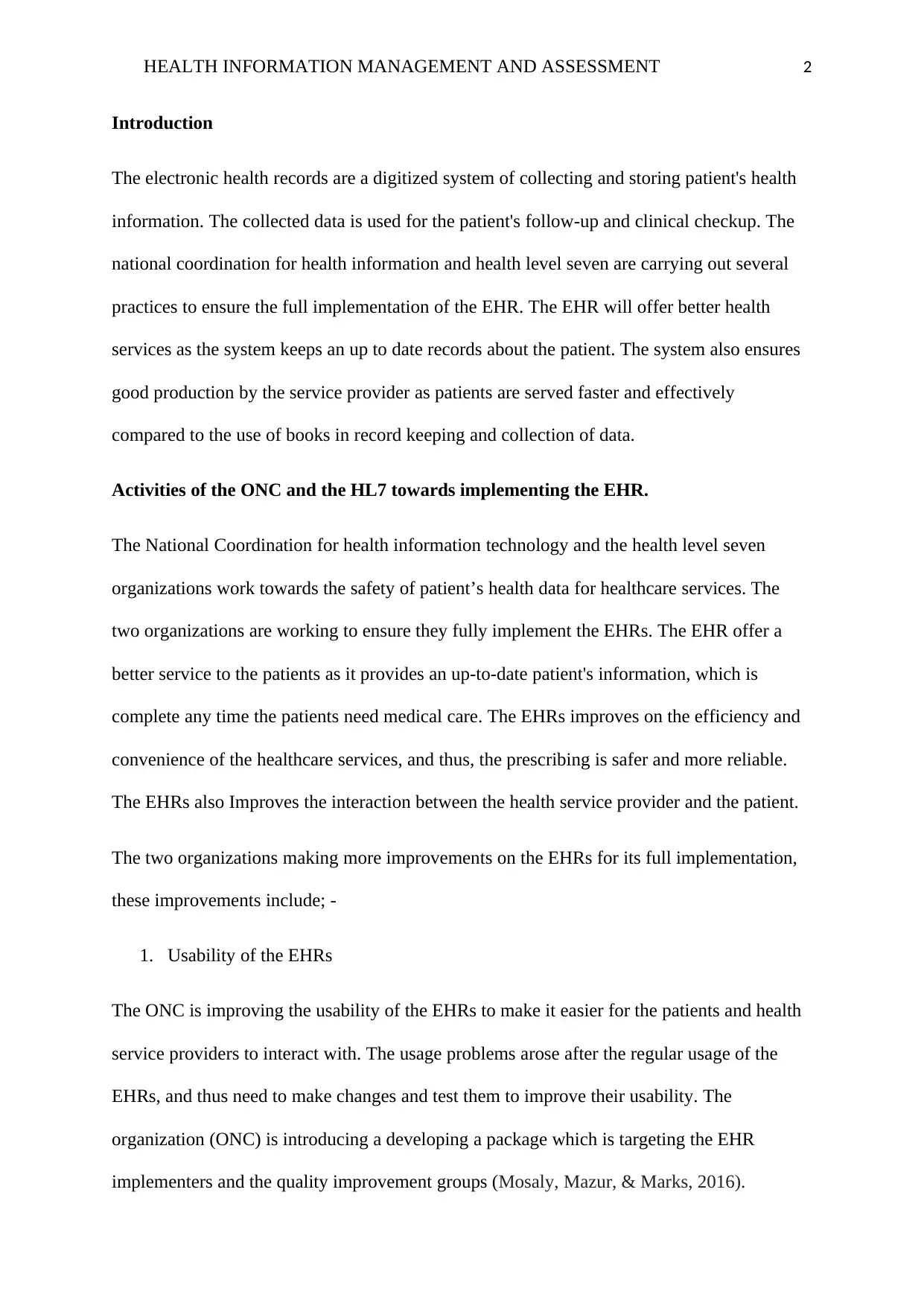
HEALTH INFORMATION MANAGEMENT AND ASSESSMENT 2
Introduction
The electronic health records are a digitized system of collecting and storing patient's health
information. The collected data is used for the patient's follow-up and clinical checkup. The
national coordination for health information and health level seven are carrying out several
practices to ensure the full implementation of the EHR. The EHR will offer better health
services as the system keeps an up to date records about the patient. The system also ensures
good production by the service provider as patients are served faster and effectively
compared to the use of books in record keeping and collection of data.
Activities of the ONC and the HL7 towards implementing the EHR.
The National Coordination for health information technology and the health level seven
organizations work towards the safety of patient’s health data for healthcare services. The
two organizations are working to ensure they fully implement the EHRs. The EHR offer a
better service to the patients as it provides an up-to-date patient's information, which is
complete any time the patients need medical care. The EHRs improves on the efficiency and
convenience of the healthcare services, and thus, the prescribing is safer and more reliable.
The EHRs also Improves the interaction between the health service provider and the patient.
The two organizations making more improvements on the EHRs for its full implementation,
these improvements include; -
1. Usability of the EHRs
The ONC is improving the usability of the EHRs to make it easier for the patients and health
service providers to interact with. The usage problems arose after the regular usage of the
EHRs, and thus need to make changes and test them to improve their usability. The
organization (ONC) is introducing a developing a package which is targeting the EHR
implementers and the quality improvement groups (Mosaly, Mazur, & Marks, 2016).
Introduction
The electronic health records are a digitized system of collecting and storing patient's health
information. The collected data is used for the patient's follow-up and clinical checkup. The
national coordination for health information and health level seven are carrying out several
practices to ensure the full implementation of the EHR. The EHR will offer better health
services as the system keeps an up to date records about the patient. The system also ensures
good production by the service provider as patients are served faster and effectively
compared to the use of books in record keeping and collection of data.
Activities of the ONC and the HL7 towards implementing the EHR.
The National Coordination for health information technology and the health level seven
organizations work towards the safety of patient’s health data for healthcare services. The
two organizations are working to ensure they fully implement the EHRs. The EHR offer a
better service to the patients as it provides an up-to-date patient's information, which is
complete any time the patients need medical care. The EHRs improves on the efficiency and
convenience of the healthcare services, and thus, the prescribing is safer and more reliable.
The EHRs also Improves the interaction between the health service provider and the patient.
The two organizations making more improvements on the EHRs for its full implementation,
these improvements include; -
1. Usability of the EHRs
The ONC is improving the usability of the EHRs to make it easier for the patients and health
service providers to interact with. The usage problems arose after the regular usage of the
EHRs, and thus need to make changes and test them to improve their usability. The
organization (ONC) is introducing a developing a package which is targeting the EHR
implementers and the quality improvement groups (Mosaly, Mazur, & Marks, 2016).
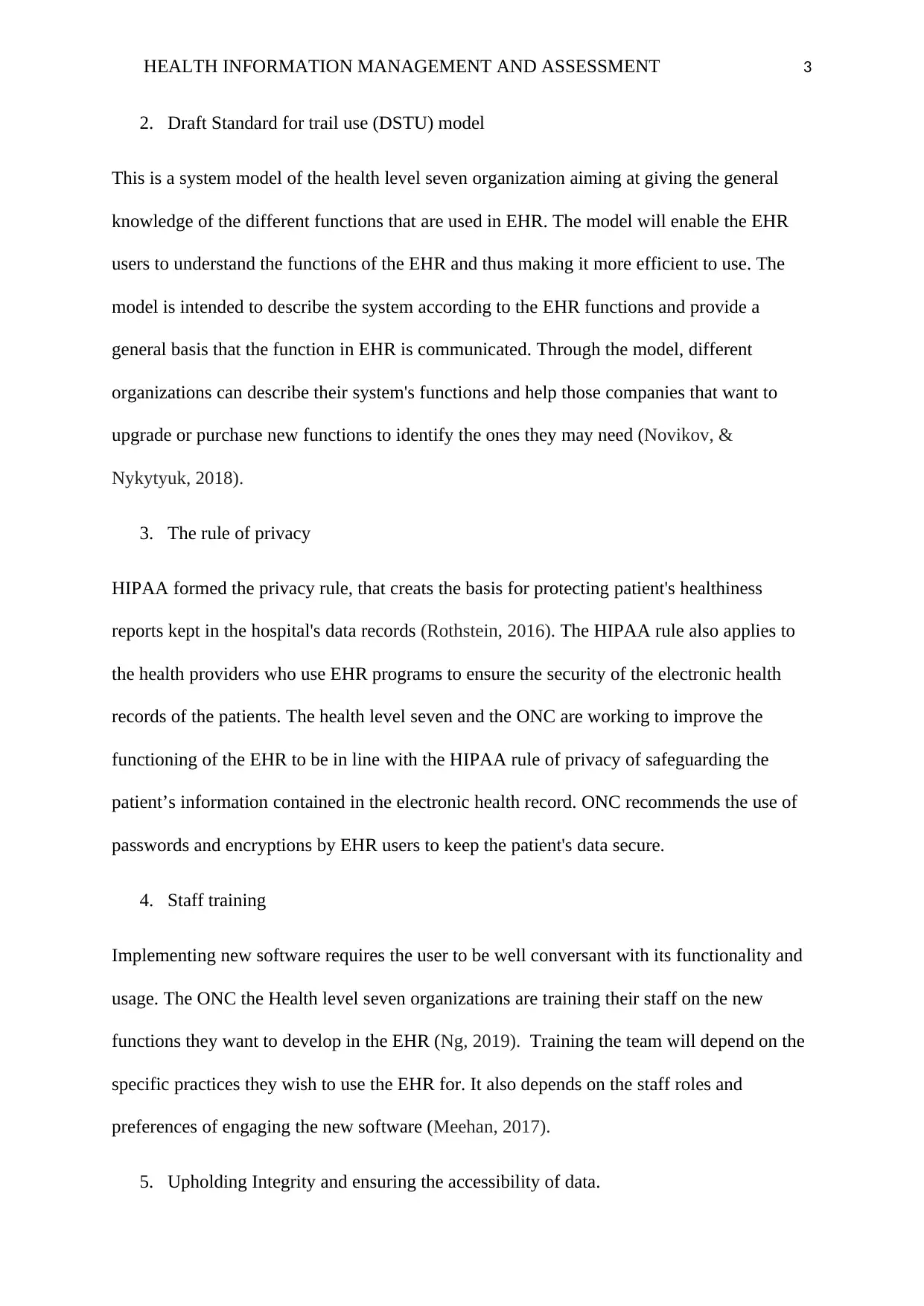
HEALTH INFORMATION MANAGEMENT AND ASSESSMENT 3
2. Draft Standard for trail use (DSTU) model
This is a system model of the health level seven organization aiming at giving the general
knowledge of the different functions that are used in EHR. The model will enable the EHR
users to understand the functions of the EHR and thus making it more efficient to use. The
model is intended to describe the system according to the EHR functions and provide a
general basis that the function in EHR is communicated. Through the model, different
organizations can describe their system's functions and help those companies that want to
upgrade or purchase new functions to identify the ones they may need (Novikov, &
Nykytyuk, 2018).
3. The rule of privacy
HIPAA formed the privacy rule, that creats the basis for protecting patient's healthiness
reports kept in the hospital's data records (Rothstein, 2016). The HIPAA rule also applies to
the health providers who use EHR programs to ensure the security of the electronic health
records of the patients. The health level seven and the ONC are working to improve the
functioning of the EHR to be in line with the HIPAA rule of privacy of safeguarding the
patient’s information contained in the electronic health record. ONC recommends the use of
passwords and encryptions by EHR users to keep the patient's data secure.
4. Staff training
Implementing new software requires the user to be well conversant with its functionality and
usage. The ONC the Health level seven organizations are training their staff on the new
functions they want to develop in the EHR (Ng, 2019). Training the team will depend on the
specific practices they wish to use the EHR for. It also depends on the staff roles and
preferences of engaging the new software (Meehan, 2017).
5. Upholding Integrity and ensuring the accessibility of data.
2. Draft Standard for trail use (DSTU) model
This is a system model of the health level seven organization aiming at giving the general
knowledge of the different functions that are used in EHR. The model will enable the EHR
users to understand the functions of the EHR and thus making it more efficient to use. The
model is intended to describe the system according to the EHR functions and provide a
general basis that the function in EHR is communicated. Through the model, different
organizations can describe their system's functions and help those companies that want to
upgrade or purchase new functions to identify the ones they may need (Novikov, &
Nykytyuk, 2018).
3. The rule of privacy
HIPAA formed the privacy rule, that creats the basis for protecting patient's healthiness
reports kept in the hospital's data records (Rothstein, 2016). The HIPAA rule also applies to
the health providers who use EHR programs to ensure the security of the electronic health
records of the patients. The health level seven and the ONC are working to improve the
functioning of the EHR to be in line with the HIPAA rule of privacy of safeguarding the
patient’s information contained in the electronic health record. ONC recommends the use of
passwords and encryptions by EHR users to keep the patient's data secure.
4. Staff training
Implementing new software requires the user to be well conversant with its functionality and
usage. The ONC the Health level seven organizations are training their staff on the new
functions they want to develop in the EHR (Ng, 2019). Training the team will depend on the
specific practices they wish to use the EHR for. It also depends on the staff roles and
preferences of engaging the new software (Meehan, 2017).
5. Upholding Integrity and ensuring the accessibility of data.
⊘ This is a preview!⊘
Do you want full access?
Subscribe today to unlock all pages.

Trusted by 1+ million students worldwide
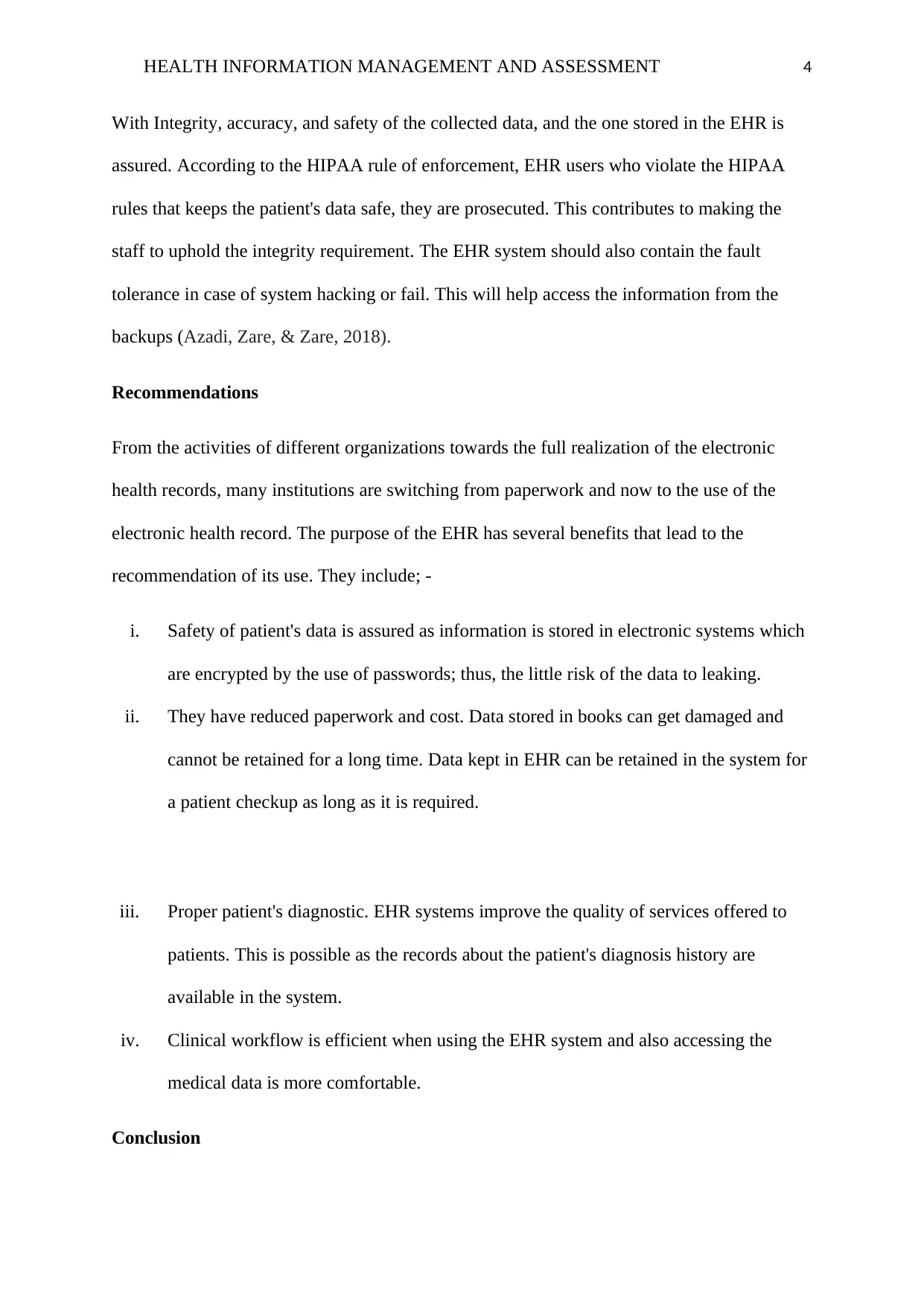
HEALTH INFORMATION MANAGEMENT AND ASSESSMENT 4
With Integrity, accuracy, and safety of the collected data, and the one stored in the EHR is
assured. According to the HIPAA rule of enforcement, EHR users who violate the HIPAA
rules that keeps the patient's data safe, they are prosecuted. This contributes to making the
staff to uphold the integrity requirement. The EHR system should also contain the fault
tolerance in case of system hacking or fail. This will help access the information from the
backups (Azadi, Zare, & Zare, 2018).
Recommendations
From the activities of different organizations towards the full realization of the electronic
health records, many institutions are switching from paperwork and now to the use of the
electronic health record. The purpose of the EHR has several benefits that lead to the
recommendation of its use. They include; -
i. Safety of patient's data is assured as information is stored in electronic systems which
are encrypted by the use of passwords; thus, the little risk of the data to leaking.
ii. They have reduced paperwork and cost. Data stored in books can get damaged and
cannot be retained for a long time. Data kept in EHR can be retained in the system for
a patient checkup as long as it is required.
iii. Proper patient's diagnostic. EHR systems improve the quality of services offered to
patients. This is possible as the records about the patient's diagnosis history are
available in the system.
iv. Clinical workflow is efficient when using the EHR system and also accessing the
medical data is more comfortable.
Conclusion
With Integrity, accuracy, and safety of the collected data, and the one stored in the EHR is
assured. According to the HIPAA rule of enforcement, EHR users who violate the HIPAA
rules that keeps the patient's data safe, they are prosecuted. This contributes to making the
staff to uphold the integrity requirement. The EHR system should also contain the fault
tolerance in case of system hacking or fail. This will help access the information from the
backups (Azadi, Zare, & Zare, 2018).
Recommendations
From the activities of different organizations towards the full realization of the electronic
health records, many institutions are switching from paperwork and now to the use of the
electronic health record. The purpose of the EHR has several benefits that lead to the
recommendation of its use. They include; -
i. Safety of patient's data is assured as information is stored in electronic systems which
are encrypted by the use of passwords; thus, the little risk of the data to leaking.
ii. They have reduced paperwork and cost. Data stored in books can get damaged and
cannot be retained for a long time. Data kept in EHR can be retained in the system for
a patient checkup as long as it is required.
iii. Proper patient's diagnostic. EHR systems improve the quality of services offered to
patients. This is possible as the records about the patient's diagnosis history are
available in the system.
iv. Clinical workflow is efficient when using the EHR system and also accessing the
medical data is more comfortable.
Conclusion
Paraphrase This Document
Need a fresh take? Get an instant paraphrase of this document with our AI Paraphraser
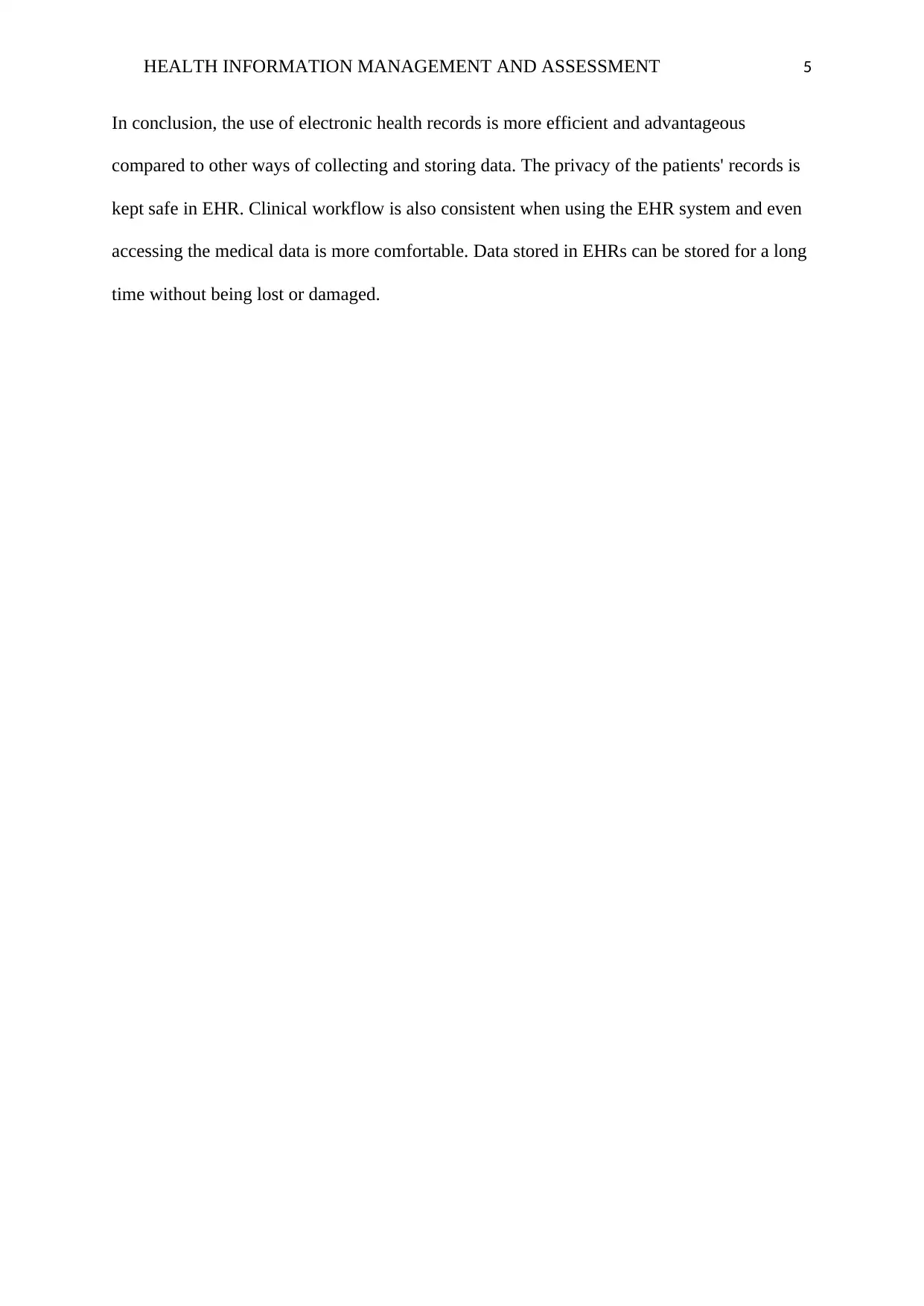
HEALTH INFORMATION MANAGEMENT AND ASSESSMENT 5
In conclusion, the use of electronic health records is more efficient and advantageous
compared to other ways of collecting and storing data. The privacy of the patients' records is
kept safe in EHR. Clinical workflow is also consistent when using the EHR system and even
accessing the medical data is more comfortable. Data stored in EHRs can be stored for a long
time without being lost or damaged.
In conclusion, the use of electronic health records is more efficient and advantageous
compared to other ways of collecting and storing data. The privacy of the patients' records is
kept safe in EHR. Clinical workflow is also consistent when using the EHR system and even
accessing the medical data is more comfortable. Data stored in EHRs can be stored for a long
time without being lost or damaged.
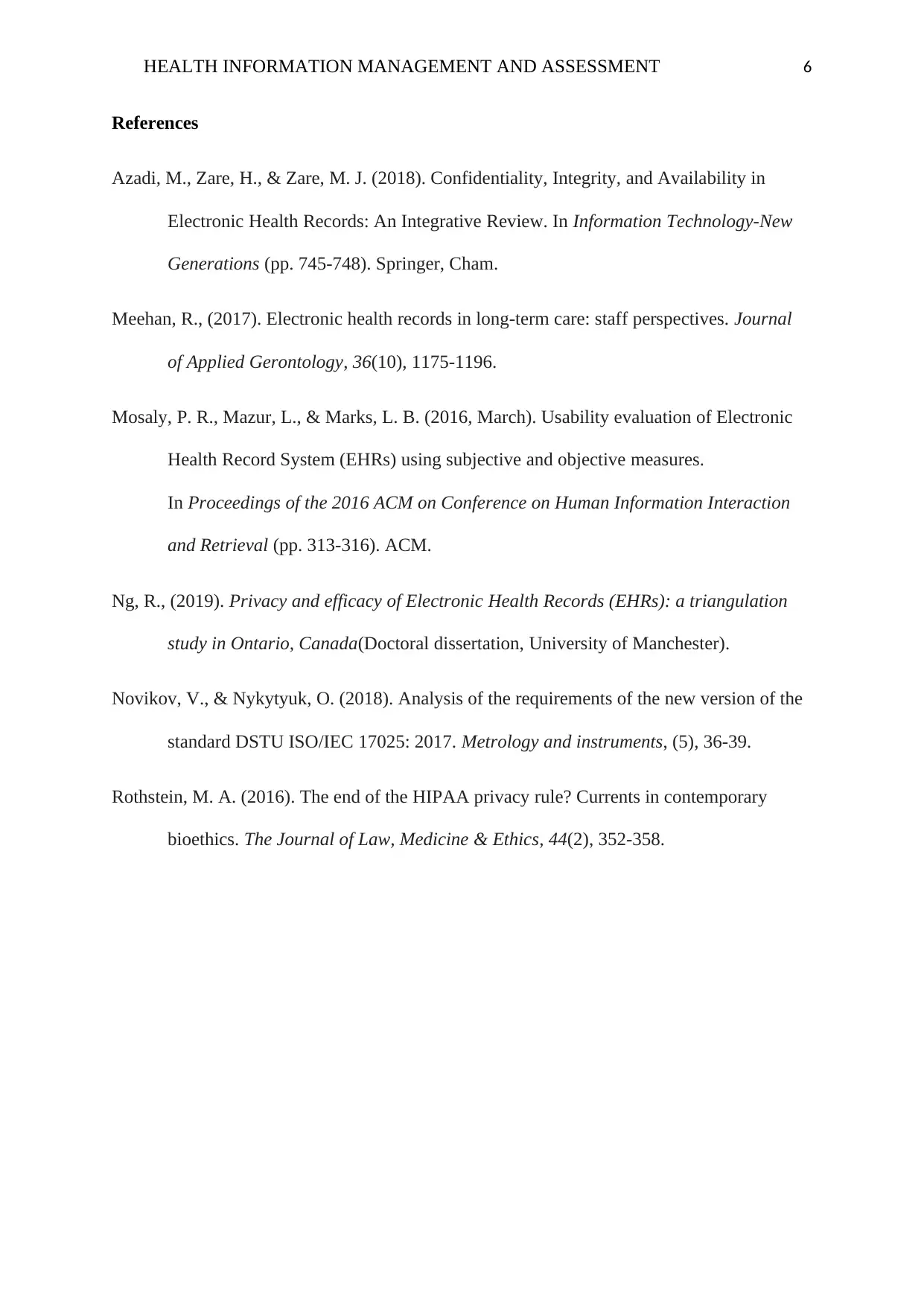
HEALTH INFORMATION MANAGEMENT AND ASSESSMENT 6
References
Azadi, M., Zare, H., & Zare, M. J. (2018). Confidentiality, Integrity, and Availability in
Electronic Health Records: An Integrative Review. In Information Technology-New
Generations (pp. 745-748). Springer, Cham.
Meehan, R., (2017). Electronic health records in long-term care: staff perspectives. Journal
of Applied Gerontology, 36(10), 1175-1196.
Mosaly, P. R., Mazur, L., & Marks, L. B. (2016, March). Usability evaluation of Electronic
Health Record System (EHRs) using subjective and objective measures.
In Proceedings of the 2016 ACM on Conference on Human Information Interaction
and Retrieval (pp. 313-316). ACM.
Ng, R., (2019). Privacy and efficacy of Electronic Health Records (EHRs): a triangulation
study in Ontario, Canada(Doctoral dissertation, University of Manchester).
Novikov, V., & Nykytyuk, О. (2018). Analysis of the requirements of the new version of the
standard DSTU ISO/IEC 17025: 2017. Metrology and instruments, (5), 36-39.
Rothstein, M. A. (2016). The end of the HIPAA privacy rule? Currents in contemporary
bioethics. The Journal of Law, Medicine & Ethics, 44(2), 352-358.
References
Azadi, M., Zare, H., & Zare, M. J. (2018). Confidentiality, Integrity, and Availability in
Electronic Health Records: An Integrative Review. In Information Technology-New
Generations (pp. 745-748). Springer, Cham.
Meehan, R., (2017). Electronic health records in long-term care: staff perspectives. Journal
of Applied Gerontology, 36(10), 1175-1196.
Mosaly, P. R., Mazur, L., & Marks, L. B. (2016, March). Usability evaluation of Electronic
Health Record System (EHRs) using subjective and objective measures.
In Proceedings of the 2016 ACM on Conference on Human Information Interaction
and Retrieval (pp. 313-316). ACM.
Ng, R., (2019). Privacy and efficacy of Electronic Health Records (EHRs): a triangulation
study in Ontario, Canada(Doctoral dissertation, University of Manchester).
Novikov, V., & Nykytyuk, О. (2018). Analysis of the requirements of the new version of the
standard DSTU ISO/IEC 17025: 2017. Metrology and instruments, (5), 36-39.
Rothstein, M. A. (2016). The end of the HIPAA privacy rule? Currents in contemporary
bioethics. The Journal of Law, Medicine & Ethics, 44(2), 352-358.
⊘ This is a preview!⊘
Do you want full access?
Subscribe today to unlock all pages.

Trusted by 1+ million students worldwide
1 out of 6
Related Documents
Your All-in-One AI-Powered Toolkit for Academic Success.
+13062052269
info@desklib.com
Available 24*7 on WhatsApp / Email
![[object Object]](/_next/static/media/star-bottom.7253800d.svg)
Unlock your academic potential
Copyright © 2020–2025 A2Z Services. All Rights Reserved. Developed and managed by ZUCOL.





